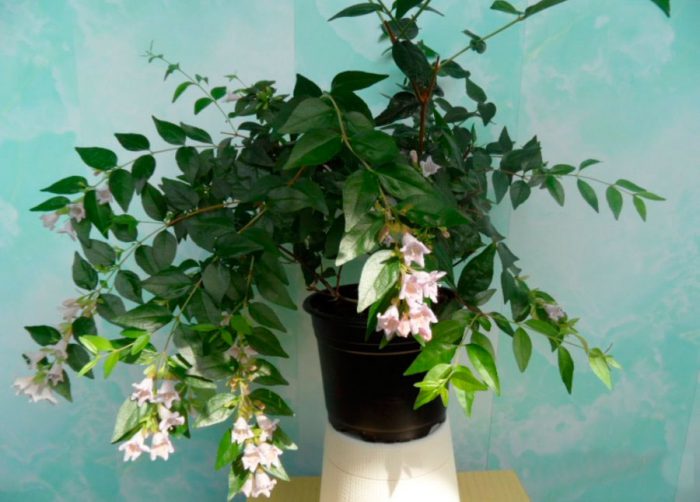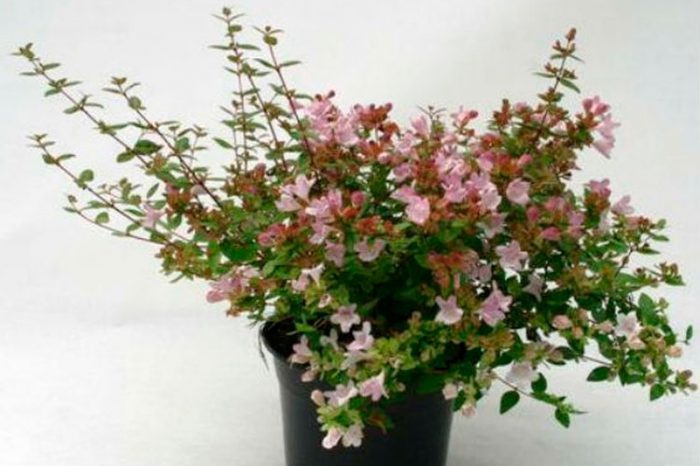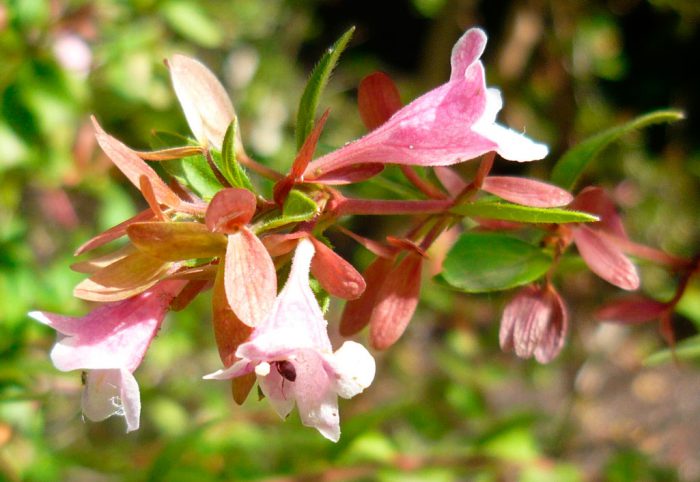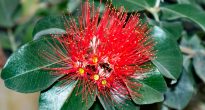An evergreen plant like abelia (Abelia) is represented as a bush. Moreover, these deciduous bushes are not very high. It belongs to the Linnaeaceae family. In the wild, abelia can be found in Mexico and Southeast Asia. This genus was named after the doctor Clark Abel, who is an Englishman and worked in China in the 19th century.
This flowering shrub has dark green foliage. These shiny leaves are opposite and have short petioles. Fragrant flowers, funnel-shaped or bell-shaped, are located on the apical as well as axillary peduncles. The oblong-shaped flowers consist of petals, the edges of which are slightly bent. They come in light pink or white. In leathery small fruits that have a curved or oblong shape, there is 1 seed.
This flower is often grown in greenhouses or used to decorate spacious rooms.
Caring for abelia at home
Illumination
This plant needs a lot of light, but it needs good shading from direct sunlight.
Temperature regime
In spring and summer, Abelia thrives at normal room temperature. In winter, it should be placed in a cool room (within 10-15 degrees). With a sharp drop in temperature, foliage may fall.
This plant does not like drafts, therefore, it is recommended to transfer it to another room when ventilating a room or to protect it from cold air currents.
Humidity
It is possible to moisten a plant from a sprayer only on hot summer days and do not overdo it, as it can easily rot. No moisture is required in winter.
How to water
In spring and summer, the plant needs abundant watering. With the onset of the autumn period, watered less, and winter watering should be scarce, but make sure that the earthy ball does not dry out completely.
Top dressing
Once every 2 weeks, you need to feed the plant with liquid flower fertilizer and only in the spring-summer period. In the autumn-winter time, feeding is stopped.
Pruning
When grown indoors, this shrub requires a fairly strong pruning in order to ensure tillering of the plant. It is carried out at the end of flowering. If the Abelia grows in the open field, then you do not need to cut it off.It is necessary from time to time to remove only damaged, dried and poorly located branches. Hedges, consisting of evergreen species, are pruned at the end of flowering. And deciduous species are pruned in February or March.
How to transplant
The transplant is carried out as needed in the spring. To do this, make an earthmouth, mixing humus, turf and peat soil, as well as sand in a ratio of 2: 2: 2: 1. The acidity of the soil should be approximately equal to pH 5.5–6.
Reproduction methods
Abelia propagates by cuttings, seeds or root shoots.
Seeds are sown in January. Seedlings grow rapidly, and the flowering of young plants may come in the same year.
Shoots and stem cuttings that remain after pruning can be propagated in the spring. For quick rooting of cuttings, it is recommended to use light soil such as peat, sand or perlite. They are placed in warmth (20-25 degrees). Cuttings quickly become lush bushes and begin to bloom that same summer.
Each year, root shoots are formed and absolutely any sprout can become a separate shrub.
Pests and diseases
Often settles on Abelia aphidcausing significant damage to the plant. Sugar discharge forms on the surface of the leaves, and then black develops on them. And they can also settle on this shrub thrips and spider mite.
Video review
Main types
Abelia grandiflora (Abelia x grandiflora)
This hybrid shrub is semi-evergreen (dependent on humidity and temperature). When grown at home, Abelia of this most common species has long, thin, drooping shoots. It is noteworthy that while the plant is young, its shoots have a light pink tint. Opposite small leaves, have an oblong shape, pointed upwards. These shiny leaves are colored dark green. Fragrant, rather large axillary flowers are five-petalled, accrete. The flowers collected in the inflorescence of the brush are painted white. Flowering is very long and abundant.
Most popular varieties:
- Francis Mason is a not very tall shrub with golden leaves.
- Edward Goucher - has red-purple leaves, reaching 2 centimeters in length.
Abelia Chinese (Abelia chinensis)
This rather high (up to 2 m) semi-evergreen shrub has many drooping and very graceful shoots. Its dark green leaves have an oval-pointed shape. And its bell-shaped flowers are painted white with small red strokes.
Abelia floribunda (Abelia floribunda)
This evergreen shrub has pubescent light red stems as well as shiny dark green leaves that are wide enough. Quite long (up to 4 centimeters), fragrant bright pink flowers have a funnel-shaped shape. This abelia begins to bloom in May or June. Flowering lasts several months in a row.
Abelia shumannii
This delicate shrub is deciduous. Its oval leaves are colored dark green. His flowers are lilac-pink, and flowering lasts from June to September.
Abelia triflora (Abelia triflora)
This deciduous and fairly resilient shrub is sometimes the size of a small tree. Its lanceolate leaves are colored dark green. Flowering begins in June. The flowers are pale pink in color.



















